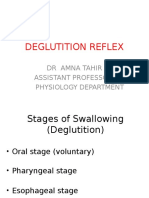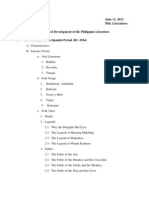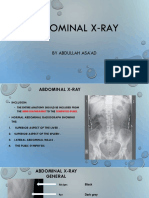Disease Description Signs and Symptoms Diagnosis Medical/Surgical MGT Description/Rationale Nursing MGT
Disease Description Signs and Symptoms Diagnosis Medical/Surgical MGT Description/Rationale Nursing MGT
Uploaded by
Nerissa Neri NatataCopyright:
Available Formats
Disease Description Signs and Symptoms Diagnosis Medical/Surgical MGT Description/Rationale Nursing MGT
Disease Description Signs and Symptoms Diagnosis Medical/Surgical MGT Description/Rationale Nursing MGT
Uploaded by
Nerissa Neri NatataOriginal Description:
Original Title
Copyright
Available Formats
Share this document
Did you find this document useful?
Is this content inappropriate?
Copyright:
Available Formats
Disease Description Signs and Symptoms Diagnosis Medical/Surgical MGT Description/Rationale Nursing MGT
Disease Description Signs and Symptoms Diagnosis Medical/Surgical MGT Description/Rationale Nursing MGT
Uploaded by
Nerissa Neri NatataCopyright:
Available Formats
Disease 1.
Achalasia 40 and above
Description Absent or ineffective peristalsis of distal esophagus, with failure of the esophageal sphincter to relax in response to swallowing Narrowing just above the stomach: increasing dilation in the upper chest
Signs and Symptoms Dysphagia (both liquid & solid) Sensation of food sticking in the lower portion of the esophagus Regurgitation happens as the dse progresses to relieve discomfort Chest pain Heartburn (pyrosis) Aspiration
Diagnosis Manometry confirms diagnosis; measures esophageal pressure. X-ray shows esophageal dilation above the narrowing at gastroesophageal junction.
Medical/Surgical Mgt Calcium channel blockers and nitrates
Description/Rationale Decrease pressure and improve swallowing Inhibits contraction of smooth muscle Stretch narrowed area Separate esophageal muscle fibers
Nursing Mgt Eat slowly Drink fluids with meals!
Botox via endoscopy Pneumatic dilation *Monitor perforation: abd tenderness, fever Esophagomyotomy laparoscopically, with or without antireflux
2. Diffuse Esophageal Spasm Women of middle age
Motor disorder Unknown cause; stress possible
Dysphagia Odynophagia Chest pain similar to coronary artery spasm
Manometry measures motility and pressure reveals simultaneous contractions. X-ray show separate areas of spasm
Conservative therapy: sedatives, long acting nitrates, calcium channel blockers Bougienage, pneumatic dilation or esophagomyotomy Esophageal Heller myotomy
Relieve pain
SFF Soft diet
If pain becomes intolerable
Transhiatal esophagectomy
Cardiac sphincter id cut, allowing food and liquids to pass into stomach Open surgical approach
3. Hiatal Hernia Women
Hiatus; Opening in the diaphragm thru which the esophagus passes becomes enlarged, part of upper stomach tends to move up to lower portion of the thorax I. Sliding: upper stomach and gastroesophageal junction are displaced upward and slide in and out of the thorax II. Paraesophageal: all part of the stomach pushes through the diaphragm beside the esophagus
Heartburn Regurgitation Dysphagia At least 50% asymptomatic Sliding: reflux Paraesophageal: sense of fullness or chest pain after eating, or no sx; no reflux because sphincter is intact
X-ray Barium swallow Endoscopy
Mgt same to gastroesophageal reflux May require emergency surgery
To correct torsion (twisting) of the stomach that leads to the restriction of blood flow
SFF Do not recline 1 hour after eating. Elevate head of bed 4-8 inch to prevent sliding
Any type: Hemorrhage Obstruction Estrangulation
4. Diverticulum Men
Outpouching of the mucosa and submucosa that protrudes through a weak portion of the musculature May occur in one of the three areas: 1. Upper: Zenkers diverticulum aka Pharyngoesophageal pulsion diveticulum or pharyngeal pouch Most common; occurs posteriorly through cricopharyngeal muscle in the midline of the neck; M >60 years
1. Upper/Zenkers/ Pharyngoesophageal: dysphagia, fullness in the neck, belching, regurgitation when lying, coughing due to irritation of trachea, gurgling noises after eating, pouch filled with food or liquid, halitosis or sour taste
Barium swallow to etermine exact nature and location Manometry for epiphrenic to rule out motor do
Contra: 1. Esophagoscopy (danger of
Pharyngoesophageal (progressive): removal of diverticulum through diverticulectomy Myotomy of cricopharyngeal muscle NGT
Care is taken to avoid trauma to common carotid and interjugular veins To relieve spasticity of the musculature
Postop: Monitor leakage from the esophagus and a developing fistula Food and fluids withheld until x-ray shows no leakage at surg. Site
2. Midesophageal uncommon, less acute, does not require surgery 3. Lower: Epiphrenic Larger, just above the diaphragm r/t improper functioning of lower esophageal sphincter or motor do 4. Intramural Occurrence of many divurticula in the upper esophagus
2. Midesophageal: less acute 3. Lower/Epiphrenic: 1/3 Asymptomatic, 2/3 dysphagia and chest pain 4. Intramural: dysphagia
perforation, mediastinitis) 2. Blind insertion of NGT
Diet begins with liquids Mid and epiphrenic: Surgery only if sx are worse, troublesome Intramural: Regress even if stricture is dilated through surgery
5. Perforation
You might also like
- Constipation Scoring System PDFDocument1 pageConstipation Scoring System PDFAgitNo ratings yet
- Medical Surgical Nursing Module 1 Lesson 1 Upper Gastrointestinal DisordersDocument34 pagesMedical Surgical Nursing Module 1 Lesson 1 Upper Gastrointestinal DisordersRomelyn Ordillas100% (2)
- Medical Surgical Nursing Study GiudeDocument5 pagesMedical Surgical Nursing Study GiudeRexson Alcantara DalanginNo ratings yet
- DYSPHAGIA FINALgDocument48 pagesDYSPHAGIA FINALgSurbhi BhartiNo ratings yet
- Intestinal Obstruction 2Document46 pagesIntestinal Obstruction 2Lawrence WanderiNo ratings yet
- Pharyngeal PouchDocument3 pagesPharyngeal PouchFreda MorganNo ratings yet
- Nur 322 Gi DisordersDocument113 pagesNur 322 Gi DisordersLovelights ZamoraNo ratings yet
- NCM 116N - TransDocument9 pagesNCM 116N - TransNEIL NETTE S. REYNALDONo ratings yet
- Oral Revalida and Comprehensive ExamDocument13 pagesOral Revalida and Comprehensive Examlovelove DayoNo ratings yet
- 2 Hiatal Hernia ManuscriptDocument4 pages2 Hiatal Hernia Manuscriptkint manlangitNo ratings yet
- Acute Abdominal PainDocument5 pagesAcute Abdominal PainLM Mys100% (1)
- Open Cholecystectomy: By: Santoyo, Sarah Jane R. BSN 3-B Group 6-Operating RoomDocument6 pagesOpen Cholecystectomy: By: Santoyo, Sarah Jane R. BSN 3-B Group 6-Operating RoomJullie Anne SantoyoNo ratings yet
- DYSPHAGIADocument76 pagesDYSPHAGIASaurabh AgarwalNo ratings yet
- Examination of Intestinal Obstruction, Acute Abdomen and Acute Appendicitis - Eugh & BwembyaDocument29 pagesExamination of Intestinal Obstruction, Acute Abdomen and Acute Appendicitis - Eugh & BwembyaForeighn97No ratings yet
- Intestinal ObstructionDocument4 pagesIntestinal ObstructionLenaFrancisNo ratings yet
- Kuliah Upper Gi Tract DiseaseDocument78 pagesKuliah Upper Gi Tract DiseaseAnggun Pulihana WNo ratings yet
- EsophagusDocument26 pagesEsophagusamadoorahmedNo ratings yet
- Gastro 1Document82 pagesGastro 1Enash RidNo ratings yet
- Surgical Disease of The Esophagus: Mahteme Bekele, MD Assistant Professor of SurgeryDocument72 pagesSurgical Disease of The Esophagus: Mahteme Bekele, MD Assistant Professor of SurgeryBiniamNo ratings yet
- Intestinal OnstructionDocument20 pagesIntestinal OnstructionFreda MorganNo ratings yet
- Diseases of Pancreas Ug ClassDocument107 pagesDiseases of Pancreas Ug ClassSrinivas PamarthiNo ratings yet
- Common Laboratory ProceduresDocument4 pagesCommon Laboratory ProceduresrahafNo ratings yet
- Visayas Community Medical Center Department of Surgery: Curan, Jan Kleen Ediza, Janseen Tortugo, Andrea MarieDocument43 pagesVisayas Community Medical Center Department of Surgery: Curan, Jan Kleen Ediza, Janseen Tortugo, Andrea MarieJanseen EdizaNo ratings yet
- What Is A Hiatus HerniaDocument8 pagesWhat Is A Hiatus HerniaLaw MlquNo ratings yet
- TBL 3: Dysphagia: By: Anis, Aishah, Nubla, Hanafi, HidayahDocument84 pagesTBL 3: Dysphagia: By: Anis, Aishah, Nubla, Hanafi, HidayahNadia RahimNo ratings yet
- Deglutition Reflex - LectureDocument38 pagesDeglutition Reflex - LectureasaadsarfrazNo ratings yet
- Diseases of EsophagusDocument46 pagesDiseases of EsophagusPlày GameNo ratings yet
- Intestinal Obstruction by DR Amir Shahzad (Autosaved)Document41 pagesIntestinal Obstruction by DR Amir Shahzad (Autosaved)MariajanNo ratings yet
- Disorders of OesophagusDocument50 pagesDisorders of Oesophagusaleenajohn9895No ratings yet
- Disorders of Motility2Document46 pagesDisorders of Motility2valdomiroNo ratings yet
- Gastrointestinal Conditions Nabs 2Document237 pagesGastrointestinal Conditions Nabs 2Yego EdwinNo ratings yet
- HIATAL HERNIA PPT Final PDFDocument49 pagesHIATAL HERNIA PPT Final PDFregy sujit60% (5)
- Intestinal Obstruction: Yohannes TDocument34 pagesIntestinal Obstruction: Yohannes TVincent Ser100% (1)
- DYSPHAGIA Lecture NotesDocument84 pagesDYSPHAGIA Lecture Notesmcmak357No ratings yet
- Esophagus SurgeryDocument75 pagesEsophagus Surgerysanjivdas100% (1)
- Biliary DisoderDocument50 pagesBiliary DisoderZanida ZainonNo ratings yet
- Gastrointestinal Tract: Monometric StudiesDocument9 pagesGastrointestinal Tract: Monometric StudiesJosh LimNo ratings yet
- Peptic Ulsers CompicationesDocument40 pagesPeptic Ulsers CompicationesMr FuckNo ratings yet
- BY: Amy Rose Abueva, Karyll Chelsea GulfanDocument19 pagesBY: Amy Rose Abueva, Karyll Chelsea GulfanAmy Rose AbuevaNo ratings yet
- Achalasia Case DiscussionDocument31 pagesAchalasia Case Discussionpavanda716No ratings yet
- PP T 16 Absorption Elimination Sir RudyDocument50 pagesPP T 16 Absorption Elimination Sir RudyJelaisa PallasigueNo ratings yet
- Achalasia AND Other Motility Disorders: Albash Sarwar Surgery ResidentDocument28 pagesAchalasia AND Other Motility Disorders: Albash Sarwar Surgery ResidentAlbash SarwarNo ratings yet
- Emergency Medicine: Acute AbdomenDocument33 pagesEmergency Medicine: Acute AbdomenPrashant MishraNo ratings yet
- Dysphagia: Muhammad Albahadili MBCHB Cabs HDLMDocument58 pagesDysphagia: Muhammad Albahadili MBCHB Cabs HDLMAli HusseinNo ratings yet
- Abdominal PainDocument39 pagesAbdominal PainIsma Resti PratiwiNo ratings yet
- ALCHALASIADocument3 pagesALCHALASIAFreda MorganNo ratings yet
- Lecture 14Document12 pagesLecture 14onlineshopping192023No ratings yet
- Gi NclexDocument14 pagesGi NclexYoke W Khoo100% (3)
- Hiatal HerniaDocument2 pagesHiatal Hernianursegian13No ratings yet
- Hiatal HerniaDocument6 pagesHiatal HerniaMaria Donabella OngueNo ratings yet
- Esophageal Motility DisordersDocument31 pagesEsophageal Motility DisordersAnonymous OlS0WZw100% (1)
- Pediatric SurgeryDocument167 pagesPediatric Surgerynanialex800No ratings yet
- პანკრეასიDocument24 pagesპანკრეასიSASIDHARNo ratings yet
- Digestive System in The Pediatric Age Group: 4 SessionDocument23 pagesDigestive System in The Pediatric Age Group: 4 SessionSven OrdanzaNo ratings yet
- 0esophagus and StomachDocument32 pages0esophagus and Stomachalihaiderinad0No ratings yet
- Gerd and Hiatal HerniaDocument4 pagesGerd and Hiatal HerniaAmoroso, Marian Corneth D.No ratings yet
- Hypertrophic Pyloric StenosisDocument22 pagesHypertrophic Pyloric StenosisRex MagallanesNo ratings yet
- HerniaDocument7 pagesHerniamuhirederick50No ratings yet
- Disorders of EsophagusDocument19 pagesDisorders of EsophagusAjibola OlamideNo ratings yet
- Dysphagia, A Simple Guide To The Condition, Treatment And Related ConditionsFrom EverandDysphagia, A Simple Guide To The Condition, Treatment And Related ConditionsRating: 5 out of 5 stars5/5 (1)
- Anapahy LabDocument4 pagesAnapahy LabNerissa Neri NatataNo ratings yet
- Granny's Recipe Book by SlidesgoDocument55 pagesGranny's Recipe Book by SlidesgoNerissa Neri Natata0% (1)
- Adult ( 18 Years) Asthma Quick Reference Guide (Update Nov 2017)Document2 pagesAdult ( 18 Years) Asthma Quick Reference Guide (Update Nov 2017)Nerissa Neri NatataNo ratings yet
- Physical Properties of Aldehydes & Ketones: SolubilityDocument3 pagesPhysical Properties of Aldehydes & Ketones: SolubilityNerissa Neri NatataNo ratings yet
- Health Threat (Smoking)Document3 pagesHealth Threat (Smoking)Nerissa Neri Natata86% (7)
- RRLDocument5 pagesRRLNerissa Neri NatataNo ratings yet
- DrugsDocument3 pagesDrugsNerissa Neri NatataNo ratings yet
- Generic / Brand Name Class and Action Indications Contraindicat-Ions Side Effects Adverse Effects Nursing ConsiderationsDocument2 pagesGeneric / Brand Name Class and Action Indications Contraindicat-Ions Side Effects Adverse Effects Nursing ConsiderationsNerissa Neri NatataNo ratings yet
- WWW - Ust.edu - PH: ODC Form 2 B O.R. Circulating FORM MajorDocument1 pageWWW - Ust.edu - PH: ODC Form 2 B O.R. Circulating FORM MajorNerissa Neri NatataNo ratings yet
- The Apostles' CreedDocument2 pagesThe Apostles' CreedNerissa Neri NatataNo ratings yet
- NatataDocument4 pagesNatataNerissa Neri NatataNo ratings yet
- GI Upset, Anorexia, Nausea, Vomiting, Constipation: and Death With OverdoseDocument4 pagesGI Upset, Anorexia, Nausea, Vomiting, Constipation: and Death With OverdoseNerissa Neri NatataNo ratings yet
- Community Development Plan CWTS Section - , GroupDocument1 pageCommunity Development Plan CWTS Section - , GroupNerissa Neri NatataNo ratings yet
- ProteinDocument3 pagesProteinNerissa Neri NatataNo ratings yet
- GI BleedDocument96 pagesGI Bleedjaish8904100% (2)
- Sensus Harian Tahun 2017Document1,522 pagesSensus Harian Tahun 2017wegiariskaNo ratings yet
- Gi Pathology - Block 3 ReviewDocument34 pagesGi Pathology - Block 3 ReviewMatt McGlothlin100% (1)
- Postvagotomy and Postgastrectomy SyndromesDocument66 pagesPostvagotomy and Postgastrectomy SyndromesCanan YilmazNo ratings yet
- Abdominal X RayDocument45 pagesAbdominal X RayAbdullah As'adNo ratings yet
- Diverticulosis TestDocument3 pagesDiverticulosis TestLyka DimayacyacNo ratings yet
- Abdominal PainDocument23 pagesAbdominal PainVajirawit PetchsriNo ratings yet
- Home Assignment 2 1Document10 pagesHome Assignment 2 1basem salehNo ratings yet
- Title: A Case Report On Left-Sided AppendicitisDocument10 pagesTitle: A Case Report On Left-Sided AppendicitispigzeniNo ratings yet
- Hepatobiliary QuizDocument8 pagesHepatobiliary QuizCharlie65129No ratings yet
- Liver Disease Questionnaire For Proposed Insured/OwnerDocument2 pagesLiver Disease Questionnaire For Proposed Insured/OwnerSincerely ReynNo ratings yet
- Case Series of Intussusception in Paediatric SurgeryDocument39 pagesCase Series of Intussusception in Paediatric SurgeryRajkiran AmbarapuNo ratings yet
- Billy Ray A. Marcelo, BSN, RN Faculty Bataan Peninsula State UniversityDocument292 pagesBilly Ray A. Marcelo, BSN, RN Faculty Bataan Peninsula State UniversityDarell M. Book100% (1)
- Gastrointestinal: Bleeding in Infants and ChildrenDocument16 pagesGastrointestinal: Bleeding in Infants and ChildrenAdelia AnggrainiNo ratings yet
- Ileus Pada Pediatrik: Syifa Sari Siregar 170100090Document39 pagesIleus Pada Pediatrik: Syifa Sari Siregar 170100090AmardiasNo ratings yet
- AchalaciaDocument2 pagesAchalaciaticolorjNo ratings yet
- Section16 - Questions and AnswersDocument62 pagesSection16 - Questions and Answersdivine venturoNo ratings yet
- Bowel Elimination: Anatomy and Physiology of GitDocument3 pagesBowel Elimination: Anatomy and Physiology of GitEmmanuelRodriguezNo ratings yet
- Diseases of Esophagus: I. GeneralDocument4 pagesDiseases of Esophagus: I. GeneralAdilMoumnaNo ratings yet
- Perianal Surgical Conditions: Fitsum ArgawDocument51 pagesPerianal Surgical Conditions: Fitsum ArgawWorku KifleNo ratings yet
- Sonography of GITDocument11 pagesSonography of GITsononik1674100% (1)
- Laporan 20 Penyakit Rawat Jalan 2021Document10 pagesLaporan 20 Penyakit Rawat Jalan 2021Puskesmas KebonpedesNo ratings yet
- Prepared by Inzar Yasin Ammar LabibDocument47 pagesPrepared by Inzar Yasin Ammar LabibJohn Clements Galiza100% (1)
- Pandora's Box FinalDocument45 pagesPandora's Box FinalPraveen CrNo ratings yet
- Acute AbdomenDocument58 pagesAcute AbdomenkharisaNo ratings yet
- Cholangitis and Cholecystitis (DR - Dr. Hery Djagat Purnomo, SpPD-KGEH)Document47 pagesCholangitis and Cholecystitis (DR - Dr. Hery Djagat Purnomo, SpPD-KGEH)Aditya SahidNo ratings yet
- Pit AnjaDocument6 pagesPit AnjaAbdullah Misini100% (1)
- Morsicatio Buccarum (Chronic Cheek Chewing) : Clinical FeaturesDocument2 pagesMorsicatio Buccarum (Chronic Cheek Chewing) : Clinical FeaturesAlbis'i Fatinzaki TsuroyyaNo ratings yet
- Propedeutics - Barrett's Esophagus - SMSDocument18 pagesPropedeutics - Barrett's Esophagus - SMSSafeer VarkalaNo ratings yet







































































































